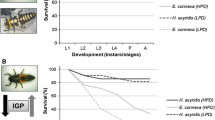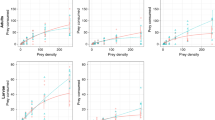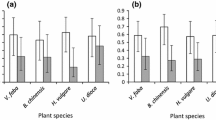Abstract
The multicolored Asian ladybeetle, Harmonia axyridis Pallas (Col, Coccinellidae), is recognized as one of the most invasive insects in the world. It has reduced the native coccinellids populations in several areas, and it is considered a threat for biodiversity at large. A significant trait, favoring its invasiveness and its dominance over indigenous ladybeetles, is intraguild predation (IGP). IGP has advantageous adaptive value for individuals: removing competitors and potential predators, and providing an alternative nutritive resource when main resources are scarce. IGP can be affected by several factors, but little is known about the effect of pesticides on this behavior. Previous research demonstrated that the invasive Asian ladybeetle is highly susceptible to the reduced-risk insecticide novaluron, a chitin synthesis inhibitor, whereas the North American indigenous competitor, Coleomegilla maculata DeGeer (Col, Coccinellidae), is not. Our study explores the adaptive value of IGP for each of the two coccinellids after preying on each other’s larvae, which were previously treated with insecticide. Our first hypothesis is that the invasive ladybeetle, susceptible to the insecticide, should lose the adaptive value of IGP. Our second hypothesis is that the adaptive value of IGP for the invasive predator will recover over time, because of neutralization of the insecticide by the intraguild prey. The results confirm both hypotheses and show that an insecticide can completely remove the adaptive value of IGP for the invader, while the adaptive value of IGP does not change for the indigenous ladybeetle. Moreover, the study demonstrates that if the intraguild prey (non-susceptible to the insecticide) undergoes molt after being exposed to the insecticide, the adaptive value for the intraguild predator is restored.






Similar content being viewed by others
References
Asplen MK, Anfora G, Biondi A, Choi DS, Chu D, Daane KM et al (2015) Invasion biology of spotted wing Drosophila (Drosophila suzukii): a global perspective and future priorities. Journal of Pest Science 88(3):469–494
Barbieri RF, Lester PL, Miller AS, Ryan KG (2013) A neurotoxic pesticide changes the outcome of aggressive interactions between native and invasive ants. Proc R Soc B Biol Sci 280:20132157. https://doi.org/10.1098/rspb.2013.2157
Baudrot V, Fernandez-de-Simon J, Coeurdassier M, Couval G, Giraudoux P, Lambin X (2020) Trophic transfer of pesticides: the fine line between predator–prey regulation and pesticide–pest regulation. J Appl Ecol 57(4):806–818
Bélanger É, Lucas É (2011) Dominance of the multicoloured Asian lady beetle Harmonia axyridis in an undisturbed wild meadow ecosystem. Eur J Environ Sci 1:7–14
Benton TG, Vickery JA, Wilson JD (2003) Farmland biodiversity: is habitat heterogeneity the key? Trends Ecol Evol 18:182–188
Berkvens N, Bonte J, Berkvens D, Deforce K, Tirry L, De Clercq P (2007) Pollen as an alternative food for Harmonia axyridis. In: From biological control to invasion: the ladybird Harmonia axyridis as a model species. Springer, Dordrecht, pp 201–210
Brown PM, Thomas CE, Lombaert E et al (2011) The global spread of Harmonia axyridis (Coleoptera: Coccinellidae): distribution, dispersal and routes of invasion. Biocontrol 56:623–641
Brown PMJ, Adriaens T, Bathon H et al (2008) Harmonia axyridis in Europe: spread and distribution of a non-native coccinellid. Biocontrol 53:5–21
Brown PMJ, Ingels B, Wheatley A et al (2015) Intraguild predation by Harmonia axyridis (Coleoptera: Coccinellidae) on native insects in Europe: molecular detection from field samples. Entomol Sci 18:130–133
Cabrera P, Cormier D, Lucas É (2018) Sublethal effects of two reduced-risk insecticides: when the invasive ladybeetle is drastically affected whereas the indigenous is not. J Pest Sci 91:1153–1164
Cabrera P, Cormier D, Lucas É (2017) Differential sensitivity of an invasive and an indigenous ladybeetle to two reduced-risk insecticides. J Appl Entomol 141:690–701
de Castro-Guedes CF, de Almeida LM, Moura MO (2020) Asymmetric intraguild predation of Harmonia axyridis (Pallas, 1773) (Coleoptera: Coccinellidae) on a native Coccinellidae guild. Revista Brasileira De Entomologia 64(1):1–7
Cattaneo MG, Yafuso C, Schmidt C et al (2006) Farm-scale evaluation of the impacts of transgenic cotton on biodiversity, pesticide use, and yield. Proc Natl Acad Sci 103:7571–7576
Cormier D, Chouinard G, Pelletier F et al (2016) An interactive model to predict codling moth development and insecticide application effectiveness. IOBC-WPRS Bull 112:65–70
Cottrell TE, Yeargan KV (1998) Intraguild predation between an introduced lady beetle, Harmonia axyridis (Coleoptera: Coccinellidae), and a native lady beetle, Coleomegilla maculata (Coleoptera: Coccinellidae). J Kansas Entomol Soc 71:159–163
Croft BA (1990) Arthropod biological control agents and pesticides. Wiley, New York
Crowder DW, Snyder WE (2010) Eating their way to the top? Mechanisms underlying the success of invasive insect generalist predators. Biol Invasions 12:2857–2876
Cutler GC, Scott-Dupree CD (2007) Novaluron: prospects and limitations in insect pest management. Pest Technol 1:38–46
Dai C, Ricupero M, Puglisi R, Lu Y, Desneux N, Biondi A, Zappalà L (2020) Can contamination by major systemic insecticides affect the voracity of the harlequin ladybird? Chemosphere 256:126986
Desneux N, Decourtye A, Delpuech JM (2007) The sublethal effects of pesticides on beneficial arthropods. Annu Rev Entomol 52:81–106
Eubanks MD, Blackwell SA, Parrish CJ et al (2002) Intraguild predation of beneficial arthropods by red imported fire ants in cotton. Environ Entomol 31:1168–1174
Evans EW, Soares AO, Yasuda H (2011) Invasions by ladybugs, ladybirds, and other predatory beetles. Biocontrol 56:597–611
Fréchette B, Cormier D, Chouinard G et al (2008) Apple aphid, Aphis spp. (Hemiptera: Aphididae), and predator populations in an apple orchard at the non-bearing stage: the impact of ground cover and cultivar. Eur J Entomol 105:521–529
Gagnon A-È, Brodeur J (2014) Impact of plant architecture and extraguild prey density on intraguild predation in an agroecosystem. Entomol Exp Appl 152:165–173. https://doi.org/10.1111/eea.12213
Gagnon A-È, Heimpel GE, Brodeur J (2011) The ubiquity of intraguild predation among predatory arthropods. PLOS ONE 6:e28061
Guedes RNC, Smagghe G, Stark JD, Desneux N (2016) Pesticide-Induced Stress in Arthropod Pests for Optimized Integrated Pest Management Programs. Annu Rev Entomol 61:43–62. https://doi.org/10.1146/annurev-ento-010715-023646
Guedes RNC, Walse SS, Throne JE (2017) Sublethal exposure, insecticide resistance, and community stress. Curr Opin Insect Sci 21:47–53
Hautier L, San Martin G, Callier P et al (2011) Alkaloids provide evidence of intraguild predation on native coccinellids by Harmonia axyridis in the field. Biol Invasions 13:1805–1814
Hodek I (2012) Diapause/dormancy. In: Hodek I, Emden HF, Honek A (eds) Ecology and behaviour of the ladybird beetles (Coccinellidae). Wiley, Chichester, pp 275–342
Honek A, Brown PM, Martinkova Z, Skuhrovec J, Brabec M, Burgio G et al (2020) Factors determining variation in colour morph frequencies in invasive Harmonia axyridis populations. Biol Invasions 22:2049–2062
Janssen A, Sabelis MW, Magalhães S et al (2007) Habitat structure affects intraguild predation. Ecology 88:2713–2719
Kabaluk JT, Vernon RS, Henderson D (2006) Population development of the green peach aphid and beneficial insects in potato fields in British Columbia. Can Entomol 138:647–660
Kolar CS, Lodge DM (2001) Progress in invasion biology: predicting invaders. Trends Ecol Evol 16:199–204
Kostyukovsky M, Trostanetsky A (2006) The effect of a new chitin synthesis inhibitor, novaluron, on various developmental stages of Tribolium castaneum (Herbst). J Stored Prod Res 42:136–148. https://doi.org/10.1016/j.jspr.2004.12.003
Labrie G, Coderre D, Lucas E (2008) Overwintering strategy of multicolored Asian lady beetle (Coleoptera: Coccinellidae): cold-free space as a factor of invasive success. Ann Entomol Soc Am 101:860–866
Lefebvre M, Bostanian NJ, Mauffette Y et al (2012) Laboratory-based toxicological assessments of new insecticides on mortality and fecundity of Neoseiulus fallacis (Acari: Phytoseiidae). J Econ Entomol 105:866–871
Lucas E (2005) Intraguild predation among aphidophagous predators. Eur J Entomol 102:351–364
Lucas E (2012) Intraguild interactions. In: Hodek I, van Emden HF, Honek A (eds) Ecology and behaviour of the ladybird beetles (Coccinellidae). Wiley, Chichester, pp 343–374
Lucas E, Coderre D, Brodeur J (1998) Intraguild predation among aphid predators: characterization and influence of extraguild prey density. Ecology 79:1084–1092
Lucas E, Giroux S, Demougeot S et al (2004a) Compatibility of a natural enemy, Coleomegilla maculata lengi (Col., Coccinellidae) and four insecticides used against the Colorado potato beetle (Col., Chrysomelidae). J Appl Entomol 128:233–239
Lucas E, Demougeot S, Vincent C, Coderre D (2004b) Predation upon the oblique-banded leafroller, Choristoneura rosaceana (Lepdidoptera: Tortricidae), by two aphidophagous coccinellids (Coleoptera: Coccinellidae) in the presence and absence of aphids. Eur J Entomol 101(1):37–41
Lucas É, Maisonhaute JE (2019) Intraguild predation. In: Encyclopedia of animal behavior, 2nd edn. Academic Press, pp 389–399
Lucas E, Vincent C, Labrie G et al (2007) The multicolored Asian ladybeetle Harmonia axyridis (Coleoptera: Coccinellidae) in Quebec agroecosystems ten years after its arrival. Eur J Entomol 104:737–743
Lundgren JG, Razzak AA, Wiedenmann RN (2004) Population responses and food consumption by predators Coleomegilla maculata and Harmonia axyridis (Coleoptera: Coccinellidae) during anthesis in an Illinois cornfield. Environ Entomol 33:958–963
McDonald JH (2009) Handbook of biological statistics. Sparky House Publishing, Baltimore
Medina P, Smagghe G, Budia F et al (2002) Significance of penetration, excretion, and transovarial uptake to toxicity of three insect growth regulators in predatory lacewing adults. Arch Insect Biochem Physiol 51:91–101
Michaud JP (2012) Coccinellids in biological control. In: Hodek I, Honek A, Van Emden HF (eds) Ecology and behaviour of the ladybird beetles (Coccinellidae). Wiley, Chichester, pp 488–519
Mills NJ, Beers EH, Shearer PW et al (2015) Comparative analysis of pesticide effects on natural enemies in western orchards: a synthesis of laboratory bioassay data. Biol Control 102:17–25. https://doi.org/10.1016/j.biocontrol.2015.05.006
Mirande L, Desneux N, Haramboure M, Schneider M (2015) Intraguild predation between an exotic and a native coccinellid in Argentina: the role of prey density. J Pest Sci 88:155–162
Mohanty B, Pandey SP, Tsutsui K (2017) Thyroid disrupting pesticides impair the hypothalamic-pituitary-testicular axis of a wildlife bird, Amandava amandava. Reprod Toxicol 71:32–41. https://doi.org/10.1016/j.reprotox.2017.04.006
Mooney HA, Cleland EE (2001) The evolutionary impact of invasive species. Proc Natl Acad Sci 98:5446–5451
Moser SE, Harwood JD, Obrycki JJ (2008) Larval feeding on Bt hybrid and non-Bt corn seedlings by Harmonia axyridis (Coleoptera: Coccinellidae) and Coleomegilla maculata (Coleoptera: Coccinellidae). Environ Entomol 37:525–533
Michaud JP, Grant AK (2005) Suitability of pollen sources for the development and reproduction of Coleomegilla maculata (Coleoptera: Coccinellidae) under simulated drought conditions. Biol Control 32(3):363–370
Müller CB, Brodeur J (2002) Intraguild predation in biological control and conservation biology. Biol Control 25:216–223. https://doi.org/10.1016/S1049-9644(02)00102-0
Muturi EJ, Donthu RK, Fields CJ et al (2017) Effect of pesticides on microbial communities in container aquatic habitats. Sci Rep 7:44565
Newman MM, Hoilett N, Lorenz N et al (2016) Glyphosate effects on soil rhizosphere-associated bacterial communities. Sci Total Environ 543:155–160. https://doi.org/10.1016/j.scitotenv.2015.11.008
Oppenoorth FJ, Welling W (1976) Biochemistry and physiology of resistance. In: Wilkinson CF (ed) Insecticide biochemistry and physiology. Springer, Boston, pp 507–551
Pejchar L, Mooney HA (2009) Invasive species, ecosystem services and human well-being. Trends Ecol Evol 24:497–504
Pell JK, Baverstock J, Roy HE, et al (2007) Intraguild predation involving Harmonia axyridis: a review of current knowledge and future perspectives. In: From biological control to invasion: the Ladybird Harmonia axyridis as a model species. Springer, pp 147–168
Polis GA, Holt RD (1992) Intraguild predation: the dynamics of complex trophic interactions. Trends Ecol Evol 7:151–154
Polis GA, Myers CA, Holt RD (1989) The Ecology and evolution of intraguild predation: potential competitors that eat each other. Annu Rev Ecol Syst 20:297–330
Provost C, Coderre D, Lucas E, Bostanian NJ (2003) Impact d’une dose subletale de lambda-cyhalothrine sur les predateurs intraguildes d’acariens phytophages en verger de pommiers. Phytoprotection 84:105–113
Riddick EW (2017) Spotlight on the positive effects of the ladybird Harmonia axyridis on agriculture. Biocontrol 62(3):319–330
Rosenheim JA, Kaya HK, Ehler LE et al (1995) Intraguild predation among biological-control agents: theory and evidence. Biol Control 5:303–335
Rundlöf M, Andersson GK, Bommarco R et al (2015) Seed coating with a neonicotinoid insecticide negatively affects wild bees. Nature 521:77–80
Sakai AK, Allendorf FW, Holt JS et al (2001) The population biology of invasive species. Annu Rev Ecol Syst 32:305–332
Santos LDCD, Santos-Cividanes TMD, Cividanes FJ, Matos STSD (2013) Biological aspects of Harmonia axyridis in comparison with Cycloneda sanguinea and Hippodamia convergens. Pesq Agrop Brasileira 48:1419–1425
SAS Institute (2016) JMP® Non parametric. https://www.jmp.com/support/help/en/16.0/index.shtml#page/jmp/nonparametric-tests.shtml
Snyder WE, Clevenger GM, Eigenbrode SD (2004) Intraguild predation and successful invasion by introduced ladybird beetles. Oecologia 140:559–565. https://doi.org/10.1007/s00442-004-1612-5
Snyder WE, Evans EW (2006) Ecological effects of invasive arthropod generalist predators. Annu Rev Ecol Evol Syst 37:95–122
Soares AO, Borges I, Borges PA et al (2008) Harmonia axyridis: what will stop the invader? Biocontrol 53:127–145
Sokal R, Rohlf J (1995) Biometry: the principles and practice of statistics in biological research, 3rd edn. W. H Freeman, New York
Strayer DL, Eviner VT, Jeschke JM, Pace ML (2006) Understanding the long-term effects of species invasions. Trends Ecol Evol 21:645–651
Traugott M, Bell JR, Raso L et al (2012) Generalist predators disrupt parasitoid aphid control by direct and coincidental intraguild predation. Bull Entomol Res 102:239–247. https://doi.org/10.1017/S0007485311000551
Vandereycken A, Durieux D, Joie É et al (2012) Habitat diversity of the Multicolored Asian ladybeetle Harmonia axyridis Pallas (Coleoptera: Coccinellidae) in agricultural and arboreal ecosystems: a review. Biotechnol Agron Soc Environ 16:553–563
Vilà M, Basnou C, Pyšek P et al (2010) How well do we understand the impacts of alien species on ecosystem services? A pan-European, cross-taxa assessment. Front Ecol Environ 8:135–144
Walsh JR, Carpenter SR, Vander Zanden MJ (2016) Invasive species triggers a massive loss of ecosystem services through a trophic cascade. Proc Natl Acad Sci 113:4081–4085
Ware R, Yguel B, Majerus M (2009) Effects of competition, cannibalism and intra-guild predation on larval development of the European coccinellid Adalia bipunctata and the invasive species Harmonia axyridis. Ecol Entomol 34:12–19
Wolf S, Romeis J, Collatz J (2018) Utilization of plant-derived food sources from annual flower strips by the invasive harlequin ladybird Harmonia axyridis. Biol Control 122:118–126
Zhang W (2018) Global pesticide use: profile, trend, cost/benefit and more. Proc Int Acad Ecol Environ Sci 8(1):1
Acknowledgements
We thank Jill Vandermeerschen for her advice with statistics, Franz Vanoosthuyse for technical support, and Chloé Savoie, Maryse Pelletier, Mathieu Lemieux, and Marie Elen Dupuis for assisting with ladybeetle bioassays. We also thank Nathan Morris for the revision of the English version.
Author information
Authors and Affiliations
Corresponding author
Ethics declarations
Conflict of interest
The authors declare that they have no conflict of interest.
Additional information
Communicated by Nicolas Desneux .
Publisher's Note
Springer Nature remains neutral with regard to jurisdictional claims in published maps and institutional affiliations.
Rights and permissions
About this article
Cite this article
Cabrera, P., Cormier, D., Bessette, M. et al. When the adaptive value of intraguild predation between an indigenous and an invasive ladybeetle is altered by an insecticide. J Pest Sci 95, 797–810 (2022). https://doi.org/10.1007/s10340-021-01404-0
Received:
Revised:
Accepted:
Published:
Issue Date:
DOI: https://doi.org/10.1007/s10340-021-01404-0




